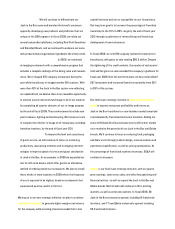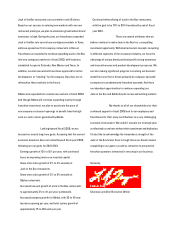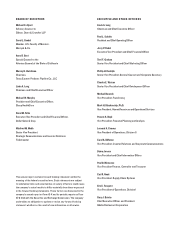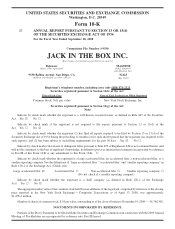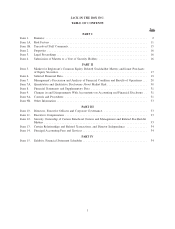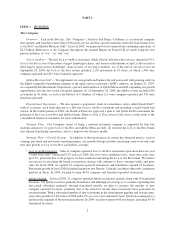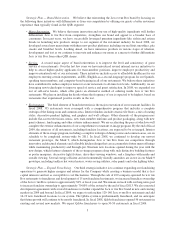Jack In The Box 2008 Annual Report Download - page 14
Download and view the complete annual report
Please find page 14 of the 2008 Jack In The Box annual report below. You can navigate through the pages in the report by either clicking on the pages listed below, or by using the keyword search tool below to find specific information within the annual report.Franchising Program
JACK IN THE BOX. Our long-term strategy is to grow the percentage of franchise ownership towards a level in
the range of 70-80% by the end of fiscal 2013, which is more closely aligned with that of the QSR industry. As of
September 28, 2008, franchisees operated 812 JACK IN THE BOX restaurants. We will continue to selectively expand
our franchising activities, including refranchising JACK IN THE BOX company-operated restaurants and the devel-
opment of new restaurants by franchisees. We offer development agreements for construction of one or more new
restaurants over a defined period of time and in a defined geographic area. Developers are required to pay a fee, a
portion of which may be credited against franchise fees due when restaurants open in the future. Developers may
forfeit such fees and lose their rights to future development if they do not maintain the required schedule of
openings.
The current JACK IN THE BOX franchise agreement generally provides for an initial franchise fee of $50,000 per
restaurant, royalties of 5% of gross sales, marketing fees of 5% of gross sales and, in most instances, a 20-year term.
Some existing agreements provide for royalty and marketing fees at rates as low as 4% and royalties as high as 15%.
In connection with the sale of a company-operated restaurant, the restaurant equipment and the right to do business
at that location are sold to the franchisee. The aggregate price is equal to the negotiated fair market value of the
restaurant as a going concern, which depends on various factors, including the history of the restaurant, its location
and its sales and cash flow potential. In addition, the land and building are leased or subleased to the franchisee at a
negotiated rent, generally equal to the greater of a minimum base rent or a percentage of gross sales. The franchisee
is usually required to pay property taxes, insurance and maintenance costs.
We view our non-franchised JACK IN THE BOX restaurants as a potential resource, which, based on our strategic
plan, can be sold to a franchisee, thereby providing increased cash flows and gains when sold while still generating
future cash flows and earnings through franchise rents and royalties.
Qdoba Mexican Grill. We plan to continue to grow the Qdoba brand, primarily through increased franchising
activities. We typically offer area development agreements for the construction of 5 to 20 new restaurants over a
defined period of time and in a defined geographic area for a development fee, a portion of which may be credited
against franchise fees due for restaurants to be opened in the future. If the developer does not maintain the required
schedule of openings, they may forfeit such fees and lose their rights to future development. The current Qdoba
franchise agreement provides for an initial franchise fee of $30,000 per restaurant, royalties of 5% of gross sales,
marketing fees of up to 2% of gross sales and, in most instances, a 10-year term with a 10-year option to extend.
Restaurant Operations
Restaurant Management. Restaurants are operated by a company-employed manager or a franchisee that is
directly responsible for the operations of the restaurant, including product quality, service, food safety, cleanliness,
inventory, cash control and the conduct and appearance of employees. Our restaurant managers are required to
attend extensive management training classes involving a combination of classroom instruction and on-the-job
training in specially designated training restaurants. Restaurant managers and supervisory personnel train other
restaurant employees in accordance with detailed procedures and guidelines using training aids available at each
location. We also use an interactive system of computer-based training (“CBT”), with a touch-screen computer
terminal at our JACK IN THE BOX restaurants. The CBT technology incorporates audio, video and text, all of which are
updated on the computer via satellite technology. CBT is also designed to reduce the administrative demands on
restaurant managers.
Regional vice presidents or regional directors supervise area coaches who supervise restaurant managers.
Under our performance system, regional vice presidents, regional directors, area coaches and restaurant managers
are eligible for periodic bonuses based on achievement of location sales, our “Voice of the Guest” consumer
feedback program, profitability and/or certain other operational performance standards.
Customer Satisfaction. We devote significant resources toward ensuring that all restaurants offer quality
food and good service. Emphasis is placed on ensuring that ingredients are delivered timely to the restaurants.
Restaurant food production systems are continuously developed and improved, and we train our employees to be
dedicated to delivering consistently good service. Through our network of distribution, quality assurance, facilities
6


